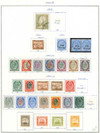
# MCC1294 - 1899-1982 Malta
Issue Dates: 1899-1982
Scott Catalogue Value: $2,078.20
Mystic Price: $1,575.00
You Save: $503.20
Extra-large Malta collection contains approximately 700 stamps and 70 album pages. Most of the stamps are in mint condition – some are also never-hinged – and more than half are in mounts.
Highlights include large sets like #77-84, the Series of 1922. The set features a mint #82, giving the set a total catalogue value of $484.50. Also #28-45, missing only #33 and #41 (total value $225) plus #60-62 valued at $180. The collection also features War Tax stamps, a few booklets and several small stamp sheets.
Officially known as the Republic of Malta, the nation consists of a small archipelago (group of islands) in the middle of the Mediterranean Sea. Only the three largest islands – Malta, Gozo, and Comino are inhabited. The two smaller islands of Cominotto and Filfla are unpopulated. Collectively, the islands have an area of 124 square miles; Malta Island has 95 square miles, Gozo has 26, and Comino has about 1.
The climate is very mild and known for its lack of frost, snow, and even fog. There are no permanent rivers or lakes. Natural harbors, rocky coves, and beaches can be found all over the islands, making them perfect for maritime industries.
Malta came under Roman control in 218 B.C. In the year 60 A.D., Saint Paul the Apostle was shipwrecked on Malta, and converted its population to Christianity. Norman (French) kings took control around 1090. In 1520, the Holy Roman Emperor Charles V inherited Malta when he became King of Spain. In 1530, Charles V gave the island to the knights of Hospitalers, an order of knights dedicated to fighting the Turks. They lost the island to the French during Napoleon’s reign.
British forces took control in 1800. Britain used Malta as an important naval base and military headquarters during both world wars. King George VI awarded the citizens of Malta the George Cross for their wartime efforts in 1942. The George Cross is today featured on the Maltese flag. Independence came slowly to Malta, but its first prime minister took office in 1964. On April 1, 1979, British sailors withdrew from Malta, ending 179 years of British rule.
Issue Dates: 1899-1982
Scott Catalogue Value: $2,078.20
Mystic Price: $1,575.00
You Save: $503.20
Extra-large Malta collection contains approximately 700 stamps and 70 album pages. Most of the stamps are in mint condition – some are also never-hinged – and more than half are in mounts.
Highlights include large sets like #77-84, the Series of 1922. The set features a mint #82, giving the set a total catalogue value of $484.50. Also #28-45, missing only #33 and #41 (total value $225) plus #60-62 valued at $180. The collection also features War Tax stamps, a few booklets and several small stamp sheets.
Officially known as the Republic of Malta, the nation consists of a small archipelago (group of islands) in the middle of the Mediterranean Sea. Only the three largest islands – Malta, Gozo, and Comino are inhabited. The two smaller islands of Cominotto and Filfla are unpopulated. Collectively, the islands have an area of 124 square miles; Malta Island has 95 square miles, Gozo has 26, and Comino has about 1.
The climate is very mild and known for its lack of frost, snow, and even fog. There are no permanent rivers or lakes. Natural harbors, rocky coves, and beaches can be found all over the islands, making them perfect for maritime industries.
Malta came under Roman control in 218 B.C. In the year 60 A.D., Saint Paul the Apostle was shipwrecked on Malta, and converted its population to Christianity. Norman (French) kings took control around 1090. In 1520, the Holy Roman Emperor Charles V inherited Malta when he became King of Spain. In 1530, Charles V gave the island to the knights of Hospitalers, an order of knights dedicated to fighting the Turks. They lost the island to the French during Napoleon’s reign.
British forces took control in 1800. Britain used Malta as an important naval base and military headquarters during both world wars. King George VI awarded the citizens of Malta the George Cross for their wartime efforts in 1942. The George Cross is today featured on the Maltese flag. Independence came slowly to Malta, but its first prime minister took office in 1964. On April 1, 1979, British sailors withdrew from Malta, ending 179 years of British rule.







